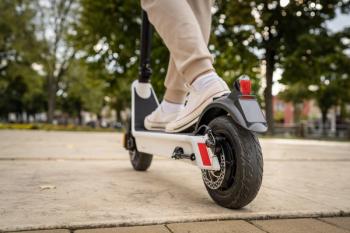
- Consultant for Pediatricians Vol 5 No 9
- Volume 5
- Issue 9
Pediatric Musculoskeletal Infections: Combating the Major Pathogens
Musculoskeletal infections in children include osteomyelitis, septic arthritis, and pyomyositis. Most of these infections are bacterial. Staphylococcus aureus is the most common organism in children in all age cat-egories. Others include group A Streptococcus, Neisseria meningitidis in purpura fulminans, Streptococcus pneumoniae, Neisseria gonorrhoeae, Mycobacterium tuberculosis, and Borrelia burgdorferi.
Musculoskeletal infections in children include osteomyelitis, septic arthritis, and pyomyositis. Most of these infections are bacterial. Staphylococcus aureus is the most common organism in children in all age cat-egories. Others include group A Streptococcus,Neisseria meningitidis in purpura fulminans, Streptococcus pneumoniae,Neisseria gonorrhoeae,Mycobacterium tuberculosis, and Borrelia burgdorferi.
In this, the second of 2 articles, we review management approaches to musculoskeletal infections in children. In part 1, which appeared in the August 2006 issue of this journal, we reviewed the principles of patient evaluation, classification of osteomyelitis and corresponding approaches to management, special forms of osteomyelitis, and diagnosis and management of septic arthritis.
Here the focus is on the significant organisms to watch out for in pediatric musculoskeletal infections.
Group A
Streptococcus
This organism is responsible for several types of musculoskeletal infections in children, especially septic arthritis. Of note, the most common complication of chickenpox is group A Streptococcus superinfection of the varicella lesions. It has been the usual infecting organism in reported cases of septic arthritis. In one study, Streptococcus pyogenes was reported to cause septic arthritis in chickenpox, especially in cases without bacterial superinfection of the skin.1
The most serious complication involves a toxic shock-like syndrome characterized by severe local tissue destruction and life-threatening systemic manifestations.2 When group A Streptococcus infection is associated with fulminant findings, aggressive resuscitation is necessary, along with timely surgical decompression of the foci of infection after a vigilant search for such sites. S pyogenes also may cause osteomyelitis or septic arthritis by hematogenous inoculation.3
Methicillin-resistant
S aureus
(MRSA)
Musculoskeletal infection with MRSA is common in septic arthritis and osteomyelitis. It may be acquired in the nosocomial setting, primari- ly in premature infants in neonatal ICUs. During the past 6 years, however, MRSA has emerged as a major pathogen in the community in many areas of the United States and around the world.4,5 Now it is emerging as a cause of skin infections in the sports community.
Transmission of S aureus--both antimicrobial-susceptible and resistant strains--usually occurs through close contact with a person who has a draining lesion or who is an asymptomatic carrier of S aureus. Factors that may contribute to transmission in athletes include abrasions and other skin trauma, which could facilitate entry of pathogens. Even with less direct contact, protective clothing may be hot and chafe skin, resulting in abrasions and lacerations. The use of shared equipment or other personal items that are not cleaned or laundered between users could be a vehicle for S aureus transmission. Previous outbreaks of staphylococcal skin infection have been reported in wrestlers and rugby and football players.
When community-acquired MRSA is suspected (Figure), the first-line options include clindamycin, the addition of an aminoglycoside and, rarely, vancomycin.6 Vancomycin is the first-line agent for MRSA infection secondary to nosocomial infection. Clindamycin may be given as the first-line drug for community-acquired MRSA, particularly in patients who are allergic to or intolerant of b-lactam antibiotics. Although a number of the newer antibiotics (eg, lin-ezolid and quinupristin/dalfopristin) have been shown to be effective against MRSA, these agents should be used only with the advice of an infection specialist.
In most patients, the clinical response determines the total duration of therapy. The number of febrile days and hospital days has increased in children with musculoskeletal infection caused by MRSA.7
Neisseria meningitidis
in Purpura Fulminans
Although N meningitidis usually is not associated with direct infection of musculoskeletal structures, it is significant as a causal organism in purpura fulminans that produces devastating musculoskeletal consequences. This is characterized by the acute onset of progressive dermal vascular thrombosis, disseminated intravascular coagulation, and shock.8
Treatment involves initial resuscitation with appropriate antibiotics. A third-generation cephalosporin, such as ceftriaxone, usually is effective.
Streptococcus pneumoniae
This organism is more commonly associated with bacteremia, pneumonia, or meningitis, but it has been reported as a causative organism for osteomyelitis and septic arthritis in infants and children. The femur and humerus are the bones most often affected, and the hip and knee are the joints most commonly involved. Immaturity of the child and concomitant immune deficiencies have been reported to increase the risks of S pneumoniae infection.9
Neisseria gonorrhoeae
Septic arthritis caused by N gonorrhoeae is monarticular or pauci- articular. Gonococcal bacteremia is more likely to be associated with polyarthralgias and skin lesions. When gonococcal infection is suspected, cultures should be obtained from joint fluid; the cervix of postpubertal girls; urethral or prostatic discharge of boys; and the vagina, pharynx, and rectum of children in whom sexual abuse is suspected. The diagnosis of N gonorrhoeae infection is confirmed by culture that needs to be done under warm conditions with low carbon dioxide levels on Thayer-Martin agar.
Management of gonococcal arthritis initially involves intravenous administration of a third-generation cephalosporin. Then, because of the prevalence of resistant strains, local aspiration and irrigation of the joint are also indicated.
Mycobacterium tuberculosis
Tuberculosis infections have been on the rise in the United States, mainly because of an influx of immigrants from high-prevalence countries and marginalized populations.10 Signs and symptoms of osteomyelitis, dactylitis, or septic arthritis may take months to years to manifest. More than half of all cases of tubercular osteomyelitis involve the spine, followed in incidence by infections around the hip and knee. Spinal involvement usually occurs in the anterior third of the vertebral body. Paravertebral abscess is almost pathognomonic.
Diagnosis requires a high index of suspicion, skin tests for tuberculosis using purified protein derivative, and identification of the organism in culture material. Often, the white blood cell count is normal but the erythrocyte sedimentation rate is elevated.
Current treatment recommendations involve quadruple-drug therapy (isoniazid, rifampin, pyrazinamide, and streptomycin) for 2 months followed by isoniazid and rifampin for another 10 months. Surgical decompression is rarely needed. Indications for spinal surgery include neurologic involvement, spinal instability, and failure of medical treatment.11
Borrelia burgdorferi
Lyme disease is caused by this spirochete; its common vector is the deer tick. Lyme disease often presents as an episodic musculoskeletal synovitis affecting 1 or more joints. It may progress to septic arthritis of the joint.
The serologic tests conducted for diagnosis are the enzyme-linked immunosorbent assay and the immunoblot (Western blot) analysis. These tests should be considered only in patients in whom there is a reasonable clinical suspicion of infection. Initial treatment consists of 10 to 30 days of oral antibiotics (amoxicillin or doxycycline). In cases of neurologic or cardiac manifestations or recurrence after oral therapy, intravenous ceftriaxone may be needed for 14 to 28 days.
A post-Lyme disease syndrome has been described as involving recurrent arthralgias, myalgias, headache, neck pain, and fatigue. Treatment with antibiotics is controversial, and spontaneous resolution within 6 months is common.12
References:
REFERENCES:
1. Bradley TM, Dormans JP.
Streptococcus pyogenes
septic arthritis of the elbow complicating the chickenpox.
Pediatr Emerg Care.
1997;13:380-381.
2. Jackson MA, Burry VF, Olson LC. Multisystem group A b-hemolytic streptococcal disease in children.
Rev Infect Dis
. 1991;13:783-788.
3. Perlman MH, Patzakis MJ, Kumar PJ, Holtom P. The incidence of joint involvement with adjacent osteomyelitis in pediatric patients.
J Pediatr Orthop
. 2000;20:40-43.
4. Chambers HF. The changing epidemiology of
Staphylococcus aureus?
Emerg Infect Dis
. 2001;7: 178-182.
5. Gwynne-Jones DP, Stott NS. Community-ac- quired methicillin-resistant
Staphylococcus aureus:
a cause of musculoskeletal sepsis in children.
J Pediatr Orthop
. 1999;19:413-416.
6. Steer AC, Carapetis JR. Acute hematogenous osteomyelitis in children: recognition and management.
Paediatr Drugs
. 2004;6:333-346.
7. Martinez-Aguilar G, Avalos-Mishaan A, Hulten K, et al. Community-acquired, methicillin-resistant and methicillin-susceptible
Staphylococcus aureus
musculoskeletal infections in children.
Pediatr Infect Dis J
. 2004;23:701-706.
8. White B, Livingstone W, Murphy C, et al. An open-label study of the role of adjuvant hemostatic support with protein C replacement therapy in purpura fulminans-associated meningococcemia.
Blood
. 2000;96:3719-3724.
9. Bradley JS, Kaplan SL, Tan TQ, et al. Pediatric pneumococcal bone and joint infections. The Pediatric Multicenter Pneumococcal Surveillance Study Group (PMPSSG).
Pediatrics.
1998;102:1376-1382.
10. Furin J, Johnson J. Recent advances in the diagnosis and management of tuberculosis.
Curr Opin Pulm Med
. 2005;11:189-194.
11. Vohra R, Kang HS, Dogra S, et al. Tuberculous osteomyelitis.
J Bone Joint Surg
. 1997;79B:562-566.
12. Weinstein A, Britchkov M. Lyme arthritis and post-Lyme disease syndrome.
Curr Opin Rheumatol
. 2002;14:383-387.
Articles in this issue
about 19 years ago
Botulinum Toxin Therapy in Children:about 19 years ago
Case In Point: An Unusual Case of Ileal-Ileo Intussusceptionabout 19 years ago
Genetic Disorders: Tetany in a 9-Year-Old Girlabout 19 years ago
A Collage of Infectious Diseases in Childrenabout 19 years ago
Erratum: Update on treatment of primary syphilisabout 19 years ago
Pediatric Migraine: Clinical Pearls in Diagnosis and Therapyabout 19 years ago
Musculoskeletal Clinics: 16-Year-Old Camper With Tibial Painabout 19 years ago
Photoclinic: Corneal Abrasionabout 19 years ago
Case In Point: Spontaneous Pneumothorax in a Teenage BoyNewsletter
Access practical, evidence-based guidance to support better care for our youngest patients. Join our email list for the latest clinical updates.














